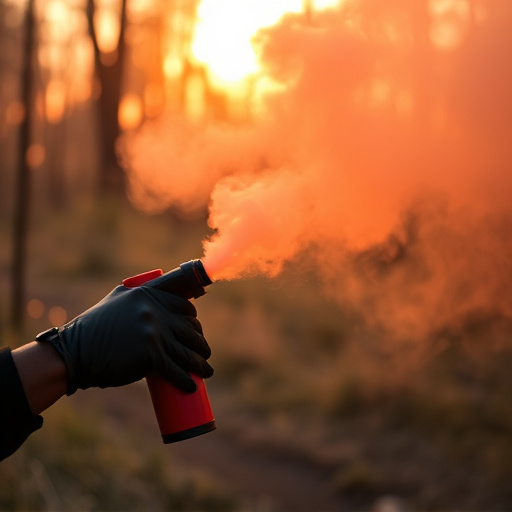The wildfire pepper spray fogger is a specialized tool used by law enforcement for crowd control, dispersing capsaicin mist to break up gatherings and deter unrest. While effective, its use raises concerns about misuse, excessive force, and health risks, especially for individuals with medical conditions. Balancing public safety and harm minimization requires continuous evaluation, training, responsible deployment, and safer alternatives like wildfire pepper spray foggers.
In today’s diverse and sometimes volatile social landscapes, police forces worldwide are increasingly relying on the wildfire pepper spray fogger as a crowd control mechanism. This article delves into the intricate world of this tool, exploring its design, function, and the complex ethical debates surrounding its use. We analyze the pros and cons, while also shedding light on safety concerns, offering a comprehensive overview of the wildfire pepper spray fogger’s role in public safety.
- Understanding Wildfire Pepper Spray Fogger: The Tool and its Mechanism
- Police Use of Pepper Spray in Crowd Control: Pros, Cons, and Ethical Considerations
- Effectiveness and Safety Concerns: A Balancing Act in Public Safety
Understanding Wildfire Pepper Spray Fogger: The Tool and its Mechanism
The wildfire pepper spray fogger is a specialized tool employed by law enforcement and crowd control teams for managing large gatherings and potential civil unrest. This device operates on the principle of dispersing a fine mist of capsaicin, the active ingredient in chili peppers, into the air. The mechanism involves a pressurized container that releases a quick burst of the pepper spray when activated. The fogger’s design allows for precise targeting, ensuring minimal impact on bystanders while effectively breaking up crowds.
This technology is particularly useful in containing rapidly escalating situations where traditional crowd-dispersal methods may be less effective or unsafe. The fogger’s ability to create a temporary visual and respiratory impairment acts as a powerful deterrent, enabling authorities to regain control of an area. Understanding the wildfire pepper spray fogger and its mechanism is key for efficient and safe crowd control in diverse scenarios.
Police Use of Pepper Spray in Crowd Control: Pros, Cons, and Ethical Considerations
Pepper spray, including advanced tools like wildfire pepper spray foggers, is a common crowd control method employed by law enforcement agencies worldwide. Its use offers several advantages in managing large gatherings and potentially violent situations. One of its primary benefits is swiftness; it can quickly disrupt and disperse crowds, providing officers with time to reassert control. This is particularly useful in scenarios involving rioting or civil unrest where rapid action is imperative. Moreover, pepper spray is non-lethal, allowing police to manage crowds without causing permanent harm, a significant ethical consideration in law enforcement tactics.
However, there are concerns regarding its use. The primary drawback is the potential for misuse, which can lead to excessive force and human rights violations. Pepper spray can cause severe discomfort, breathing difficulties, and even temporary blindness, especially when used irresponsibly. Additionally, certain individuals may have medical conditions that make them more susceptible to the effects of pepper spray, raising ethical questions about its deployment in such cases. Balancing crowd control effectiveness with the risk of causing harm is an ongoing challenge for law enforcement, especially as advanced tools like wildfire foggers introduce new variables into this delicate equation.
Effectiveness and Safety Concerns: A Balancing Act in Public Safety
Pepper spray, including advanced tools like wildfire pepper spray foggers, has been a staple in crowd control tactics for law enforcement agencies. Its effectiveness in incapacitating individuals and dispersing large gatherings is well-documented. The rapid onset of irritation and subsequent disability allows police to manage volatile situations, ensuring public safety. However, the use of such force also raises significant safety concerns among both officers and bystanders.
The balance between maintaining public order and minimizing potential harm necessitates continuous evaluation and reform in crowd control strategies. Concerns regarding excessive force, accidental exposure, and health risks associated with pepper spray have sparked debates. Officers must be rigorously trained to ensure they use these tools responsibly, only deploying them as a last resort when other de-escalation methods fail. Moreover, the development of safer alternatives and continuous research into the impact of pepper spray on various populations remain crucial aspects in addressing these safety concerns.
The wildfire pepper spray fogger, as a powerful crowd control tool, offers both advantages and drawbacks. While it can effectively disrupt large gatherings and reduce physical harm during volatile situations, its use raises significant ethical concerns regarding individual rights, public safety, and the potential for abuse. As law enforcement agencies continue to employ this tactic, striking a balance between maintaining public order and upholding civil liberties remains paramount, emphasizing the importance of rigorous training, transparent policies, and continuous evaluation of alternative non-lethal technologies.
